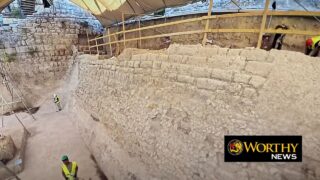Monumental 2,800-Year-Old Dam Uncovered in City of David – Largest Ever Found in Ancient Israel

JERUSALEM (Worthy News) – Archaeologists in Jerusalem’s City of David have uncovered the largest dam ever found in ancient Israel, a monumental waterworks dating back nearly 2,800 years to the reign of Kings Joash or Amaziah of Judah.
The massive structure, excavated in the Siloam Pool area of the City of David National Park, was built around 805-795 BCE, according to a joint study by the Israel Antiquities Authority (IAA) and the Weizmann Institute of Science. Published Monday in the prestigious journal PNAS, the study reveals that the dam was likely constructed as a bold response to a climate crisis that struck the region nearly three millennia ago.
A Colossal Discovery
“This is the largest dam ever discovered in Israel and the earliest one ever found in Jerusalem,” announced excavation directors Dr. Nahshon Szanton, Itamar Berko, and Dr. Filip Vukosavović. “Its dimensions are remarkable: about 12 meters high, over 8 meters wide, and 21 meters long – and it continues beyond what has been excavated. It was designed both to gather waters from the Gihon Spring and to divert floodwaters rushing down the Tyropoeon Valley into the Kidron Stream.”
Researchers explained that the project served a dual purpose: supplying Jerusalem’s growing population with fresh water while preventing devastating flash floods. Advanced radiocarbon dating of organic material embedded in the mortar pinpointed its construction with extraordinary accuracy to within a decade – a rare achievement in archaeology.
Climate, Kings, and the Bible
The Weizmann Institute team, led by Dr. Johanna Regev and Prof. Elisabetta Boaretto, cross-referenced their findings with climate data from the Dead Sea, Soreq Cave, and solar records. The evidence pointed to a period of prolonged drought punctuated by sudden, violent storms. The dam’s construction, they concluded, was a royal initiative to protect and sustain the capital during environmental upheaval.
The dating firmly situates the project during the reigns of King Joash, who restored the Temple (2 Kings 12:5), or his son Amaziah, remembered for strengthening Judah before his eventual downfall (2 Kings 14:3). The dam thus reflects not only engineering ingenuity but also the resilience of a kingdom seeking survival under divine mandate.
Waterworks of the Holy City
The newly revealed dam joins other monumental water systems in the City of David, including a fortified tower guarding the Gihon Spring and a channel directing water into the Siloam Pool. Together, these systems reveal Jerusalem in the late 9th century BCE as a city of advanced engineering, strategic foresight, and spiritual significance.
The Siloam Pool itself carries deep biblical resonance. It is remembered in the Gospel of John as the site where Jesus healed a man born blind: “Go, wash in the Pool of Siloam… So he went and washed and came back seeing” (John 9:7). For pilgrims ascending to the Temple, it was also a place of ritual purification.
Awe-Inspiring Remains
Eli Escusido, Director of the IAA, hailed the find as “one of the most impressive and significant First Temple-period remains in Jerusalem, preserved to an extraordinary degree.”
Heritage Minister Rabbi Amichai Eliyahu added, “This dam is tangible evidence of the strength of the Kingdom of Judah and the creativity of its kings in dealing with natural and environmental challenges. Already 2,800 years ago, Jerusalem’s residents applied outstanding engineering solutions to a climate crisis. This discovery fuses exact sciences with archaeology and sheds indisputable light on our nation’s history.”
The findings will be formally presented in September at the 26th City of David Studies Conference under the theme “The Lost Pool – The Enigma of Siloam.”
Prophetic Significance: The Pool of Siloam and Living Water
The Pool of Siloam is not only an archaeological treasure but also a prophetic symbol. In John 7, on the last and greatest day of the Feast of Tabernacles, Jesus stood in the Temple and declared:
“If anyone thirsts, let him come to Me and drink. He who believes in Me, as the Scripture has said, out of his innermost being will flow rivers of living water.” (John 7:37–38)
This declaration carried powerful imagery. During the feast, water was drawn from the Pool of Siloam in a joyous procession and poured out at the altar, symbolizing both God’s provision and the hope for future salvation. By pointing to Himself as the true source of “living water,” Jesus fulfilled the prophetic meaning behind the ritual.
Now, as excavations reopen and literally re-dig the Pool of Siloam—buried and hidden for centuries—there is a prophetic echo of Isaac’s servants in Genesis 26 who re-dug the wells of their fathers. The uncovering of the pool in our day speaks to a spiritual uncovering: God is redigging the wells of living water, preparing the way for revival in Jerusalem and the nations.
As the ancient dam and pool are revealed stone by stone, they remind us that the waters of life flow not only in history but through Jesus, who alone satisfies spiritual drought. The physical restoration of Jerusalem’s water systems foreshadows the promise of Zechariah 14:8: “On that day living waters shall flow out from Jerusalem.”
💡 Did you know? One of the best ways you can support Worthy News is by simply leaving a comment and sharing this article.
📢 Social media algorithms push content further when there’s more engagement — so every 👍 like, 💬 comment, and 🔄 share helps more people discover the truth. 🙌
Latest Worthy News
If you are interested in articles produced by Worthy News, please check out our FREE sydication service available to churches or online Christian ministries. To find out more, visit Worthy Plugins.
